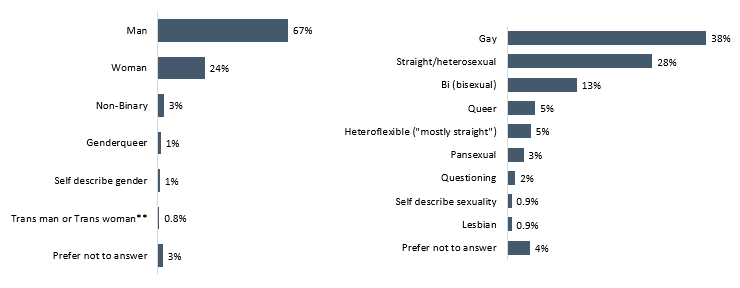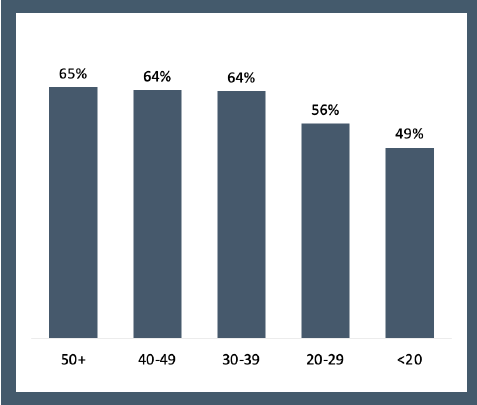First-quarter: June, July and August 2021
Authors: Sean B. Rourke, Rick Galli, Kristin McBain, Darshanand Maraj, Janice Duddy, Leanne Zubowski, James Watson, Colleen Westendorf, Wangari Tharao, Maureen Owino, Muna Aden, Nathan Lachowsky, Christopher Draenos, Simon Child and the I’m Ready Study Team.
Access this report as a PDF (English only).
Goals & Background
The goal of the I’m Ready research program is to reach the estimated 8000+ people living with HIV in Canada who remain undiagnosed. REACH Nexus at St. Michael’s Hospital implemented the I’m Ready research program in June 2021, just 7 months after the first HIV self-test was licensed in Canada.
How it works
Through the I’m Ready, Test mobile app, participants create an anonymous profile, answer surveys, order up to 3 free HIV self-tests for delivery or pick-up at community sites, take the test, and share results. Participants can connect directly to peer navigator support before, during or after taking the test through the integrated
I’m Ready, Talk telehealth platform. They can use self-test kits to test themselves or share the kits with other people in their social network. Anyone in Canada over 18 years of age is eligible to join I’m Ready.
First-quarter key findings
• 14,000+ website visitors
• 1,579 people consented and entered the study through the I’m Ready, Test app
• 1,311 participants started the pre-test survey
• 1,100 participants ordered 2,653 HIV self-test kits for delivery or pick up
• 496 participants added at least one test result
3 positive test results submitted, all from key populations.
Participants: where they live, who they are
We gather demographic data when people do the pre-test survey. This is how we learned about who our participants are and where they live.
Chart 1: Geographic location of I’m Ready participants
Of the 1311 participants that started a pre-test survey, the highest number of participants (43%) who enrolled in the pre-test survey resided in Ontario, followed by 23% of participants who resided in Quebec, 13% in BC, 5% in Manitoba, 4% in Alberta, 4% in Nova Scotia, 3% in Newfoundland and Labrador, 2% in New Brunswick, 1% in PEI, 1% in Saskatchewan and 1% in the Territories.
Chart 2: The location size of places where participants resided.
58% of participants lived in very large urban areas with a population greater than 200K; 17% lived in large urban areas with a population from 100-199K; 14% lived in medium-sized areas with a population of 30-99K; 8% lived in small areas with a population of 1-29K; and 2% lived in areas with a rural population of less than 1K.
We also learned social demographic information in the pre-test survey. We know that 46% of I’m Ready participants are under 30; the mean age of all participants is 33 years; and 90% of participants use the app in English, while 10% use it in French.
Chart 3: Social demographic information for participants enrolled in the pre-test survey.
The below chart on the left shows that 67% of the participants that completed the pre-test survey identified as a man, followed by 24% who identified as a woman, 3% as non-binary, 1% as genderqueer and 0.8% as transgender. 3% preferred not to answer.
The chart on the right shows that 38% of participants identified as gay, 28% as straight/heterosexual, and 13% identified as bisexual. 5% identified as queer; 5% identified as “heteroflexible”/ “mostly straight”; 2% identified as questioning, 0.9% self-described their identity, 0.9% identified as lesbian, and 4% preferred to not answer.
Participants may be represented in more than one group. Indigenous participants were asked separately whether they were “Two-Spirit.” These results will be shared in future summaries.
**Aggregated because cell size was < 5.
Every Canadian should have access, choice and support for HIV testing and care, regardless of who they are or where they live.
Dr. Sean B. Rourke, Director, REACH Nexus
First-time testers reached by I’m Ready
Before participants order an HIV self-test we ask them about their testing history in the pre-test survey. We were also able to compare the size of the communities where first-time testers lived. These are the results according to the ages and locations of participants.
- 329 participants across all ages self-reported as first-time testers, which represents about 25% of all participants.
- One person who tested positive identified as a first-time tester.
Chart 4: Age categories of participants that self-reported as first-time testers.
The below bar graph shows all participants (blue bars) and of those participants, which ones were first-time testers (aqua bars). Under 20 years old, 49% of 41 participants were first-time testers. For first-time testers ages 20-29, 32% of 556 participants were first-time testers. In the age range 30-39, 18% of 441 participants were first-time testers. For those 40-49, 18% of 176 participants were first-time testers, and for the 97 participants who were over 50, 21% were first-time testers.
Chart 5: First-time testers by location size
30% of first-time testers lived in very large urban areas with a population greater than 200K; 30% lived in large urban areas with a population from 100-199K; 33% lived in medium-sized areas with a population of 30-99K; 23% lived in small areas with a population of 1-29K; and 22% lived in areas with a rural population of less than 1K.
Key populations
While anyone in Canada 18 and over is eligible to join the I’m Ready research program, I’m Ready is especially aiming to reach four key populations who are disproportionately affected by HIV in Canada:
• people who are African, Caribbean and/or Black (ACB);
• gay, bisexual and other men who have sex with men (gbMSM);
• people who use and inject drugs (PWID); and
• Indigenous Peoples (First Nations, Inuit and Métis).
Participants may belong to more than one of these key populations.
In this first quarter, we’re not reaching all key populations to the same degree. We are reaching a significant number of gbMSM across Canada. We’ve also reached 82 ACB people in Ontario and 28 in Quebec. We have reached only 19 Indigenous people in Ontario, 11 in BC and 22 across the Prairies. We’ve had a small number of participants who use drugs enter the study: 15 in Ontario and 10 in Quebec, but only a few in other regions.
Charts 6 & 7
Chart 6: Participants who identified with one or more key population(s).
Nearly half of all participants (48%) identified as gbMSM, while 10% of participants identified with ACB communities, 5% with Indigenous communities and 3% with people who use and inject drugs.
(Participants can select more than one identity.)
Chart 7: The ages categories of participants who identified with key populations.
Half or more participants from each age category were part of key populations. Among participants aged 50+, 65% identified with one or more key population, while 64% in between ages 40-49, 64% between ages 30-39, 56% between ages 20-29 and 49% below age 20 years old. Participants from key populations made up 60% of all participants.
We designed I’m Ready to create access and choice for testing and care in ways that can work for key populations in their communities. This is critical for reaching people who are undiagnosed so they can begin their journey for treatment and care; it’s also crucial to ending HIV transmission in Canada.
Dr. Sean B. Rourke, Director, REACH Nexus
Where did we distribute HIV self-test kits?
After participants finish the pre-test survey they can order up to three kits for delivery or pick up. 1,100 participants have ordered a total of 2,653 HIV self-test kits.
- 69% of kits (1,618) were delivered.
- I’m Ready has 80 pickup locations across Canada. 31% of kits (1,035) were ordered for pick up at one of these community locations. Future summaries will include more about this.
Chart 8: Where test kits have been delivered in Canada (1,618 total)
This map infographic shows where kits were delivered in Canada. In British Columbia, 200 were delivered; in Alberta 87 were delivered. In Manitoba, 14 were delivered; in Saskatchewan, 87; In Ontario, 666; In Quebec, 391; In New Brunswick, 30 ; In Newfoundland and Labrador, 37; in Nova Scotia, 90; and in Prince Edward Island, 16.
Who shared test results in the app?
After getting their test kits, participants are asked to submit their test result in the I’m Ready, Test app. 496 participants reported the result of at least one test. Participants get follow-up surveys at 1, 3 and 6 months.
Chart 9: The province of residency among participants who shared test results.
The highest number of participants (N=228) who shared survey results on the app resided in Ontario, followed by 95 participants in Quebec, 61 in BC, 28 in Manitoba, 23 in Alberta, 19 in Nova Scotia, 17 in Newfoundland and Labrador, 14 in New Brunswick, 6 in PEI and 5 participants in Saskatchewan.
3 participants submitted a positive test result in the app. Each person belonged to at least one key population. This means that I’m Ready was able to reach at least 3 people who were previously undiagnosed.
Peer navigation support: I’m Ready, Talk
I’m Ready’s peer navigators undergo over 6 months of specialized training. They are a critical part of ensuring I’m Ready participants are supported before, during and after they self-test for HIV—and by someone they can feel comfortable with. Each peer brings their own lived experience to the table.
In I’m Ready’s first quarter:
• 17 peers were on the schedule rotation;
• 13 had at least one appointment;
• 46 total appointments booked;
• 33% of appointments were video, while 67% were message (chat)-based; and
• 93% of appointments were in English, 7% were in French.
Thank you
I’m Ready, brought to you by REACH Nexus at MAP Centre for Urban Health Solutions, St. Michael’s Hospital, Unity Health Toronto, is possible thanks to the generous and ongoing support of our funders, and the collaboration of our partners, including our 80+ community pickup locations across Canada. Learn more about I’m Ready and our partnerships at readytoknow.ca.
Published: Oct. 15, 2021








